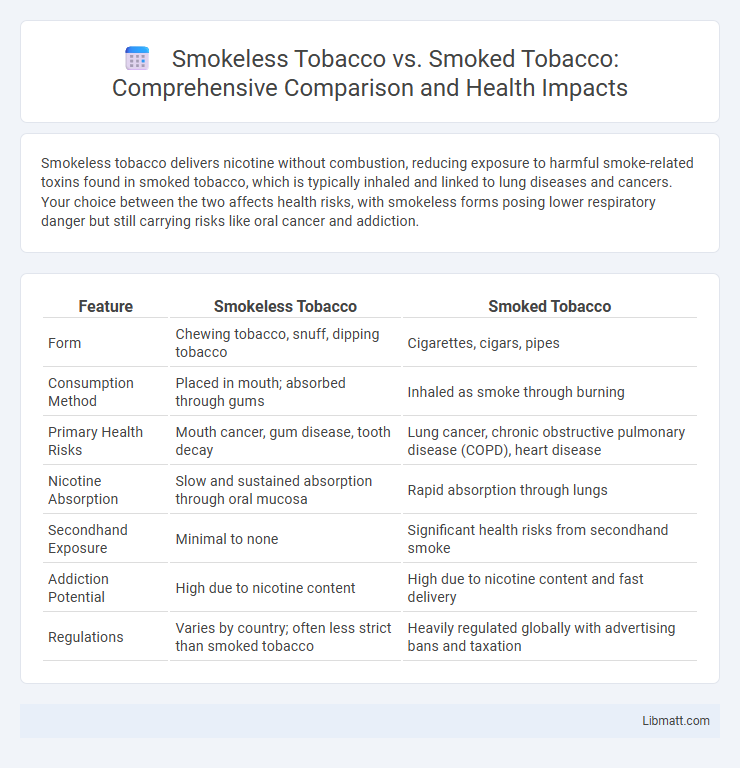Smokeless tobacco delivers nicotine without combustion, reducing exposure to harmful smoke-related toxins found in smoked tobacco, which is typically inhaled and linked to lung diseases and cancers. Your choice between the two affects health risks, with smokeless forms posing lower respiratory danger but still carrying risks like oral cancer and addiction.
Table of Comparison
| Feature | Smokeless Tobacco | Smoked Tobacco |
|---|---|---|
| Form | Chewing tobacco, snuff, dipping tobacco | Cigarettes, cigars, pipes |
| Consumption Method | Placed in mouth; absorbed through gums | Inhaled as smoke through burning |
| Primary Health Risks | Mouth cancer, gum disease, tooth decay | Lung cancer, chronic obstructive pulmonary disease (COPD), heart disease |
| Nicotine Absorption | Slow and sustained absorption through oral mucosa | Rapid absorption through lungs |
| Secondhand Exposure | Minimal to none | Significant health risks from secondhand smoke |
| Addiction Potential | High due to nicotine content | High due to nicotine content and fast delivery |
| Regulations | Varies by country; often less strict than smoked tobacco | Heavily regulated globally with advertising bans and taxation |
Introduction to Smokeless and Smoked Tobacco
Smokeless tobacco includes products like chewing tobacco, snuff, and dissolvables, which are used without burning, delivering nicotine through the oral or nasal mucosa. Smoked tobacco encompasses cigarettes, cigars, and pipes, where tobacco combustion produces smoke inhaled into the lungs. Your understanding of these distinct forms is crucial for assessing health risks linked to nicotine addiction and carcinogen exposure.
Types of Smokeless Tobacco
Smokeless tobacco includes various types such as chewable tobacco, snuff, snus, and dissolvable tobacco products, each delivering nicotine without combustion. Chewable tobacco involves placing tobacco leaves between the gum and cheek, while snuff is finely ground tobacco inhaled or placed in the mouth. Snus, a moist powder tobacco product originating from Sweden, and dissolvable tobacco, available in strips or tablets, offer discreet alternatives to smoked tobacco but still pose significant health risks.
Types of Smoked Tobacco
Smoked tobacco primarily includes cigarettes, cigars, pipes, and hookahs, each delivering nicotine through combustion. Cigarettes are the most widely consumed form, characterized by quick nicotine absorption and high exposure to harmful tar and carbon monoxide. Cigars and pipes produce more smoke but are often used less frequently, while hookahs involve water filtration but still expose users to significant toxicants and carcinogens.
Chemical Composition: Smokeless vs Smoked Tobacco
Smokeless tobacco contains higher concentrations of nicotine, nitrosamines, and heavy metals due to its unburned form, whereas smoked tobacco produces toxic compounds like tar, carbon monoxide, and polycyclic aromatic hydrocarbons through combustion. The chemical composition of smoked tobacco includes carcinogens primarily formed during burning, while smokeless tobacco's chemicals are derived from curing and fermentation processes. Differences in chemical profiles influence health risks, with smokeless tobacco posing risks mostly related to oral cancers and nicotine addiction, whereas smoked tobacco increases risks for respiratory diseases and systemic carcinogenesis.
Health Risks Associated with Smokeless Tobacco
Smokeless tobacco poses significant health risks, including increased chances of oral cancer, gum disease, and tooth decay due to prolonged exposure to harmful chemicals like nicotine and carcinogens. Unlike smoked tobacco, it bypasses the lungs but still delivers addictive substances that can lead to cardiovascular issues and adverse effects on your overall oral health. Understanding these risks is essential for making informed decisions about tobacco use and protecting your well-being.
Health Risks Associated with Smoked Tobacco
Smoked tobacco poses significant health risks due to the inhalation of toxic chemicals and carcinogens released during combustion, leading to lung cancer, chronic obstructive pulmonary disease (COPD), and cardiovascular diseases. The tar and carbon monoxide in smoked tobacco damage lung tissue and reduce oxygen delivery, increasing the likelihood of respiratory infections and heart attacks. Understanding these dangers can help you make informed decisions about tobacco use and prioritize your long-term health.
Addiction Potential and Nicotine Content Comparison
Smokeless tobacco products often contain higher concentrations of nicotine than smoked tobacco, leading to a strong addiction potential that can be as severe or greater than cigarettes. The absorption of nicotine through the oral mucosa in smokeless tobacco results in a slower but sustained nicotine release, contributing to prolonged dependence. Understanding the differences in nicotine delivery can help you navigate cessation strategies more effectively.
Social and Cultural Perceptions
Smokeless tobacco and smoked tobacco carry distinct social and cultural perceptions shaped by regional traditions and public health narratives. Smokeless tobacco is often viewed as a discreet alternative within certain communities, whereas smoked tobacco is more widely associated with social rituals and media representation but faces increasing stigma due to health concerns. Your awareness of these perceptions can influence personal choices and social interactions related to tobacco use.
Regulatory Approaches and Legal Differences
Regulatory approaches to smokeless tobacco and smoked tobacco vary significantly worldwide, with many countries imposing stricter packaging, advertising, and sales restrictions on smoked tobacco due to its higher health risks. Legal differences often include age restrictions, taxation levels, and public usage bans, with smoked tobacco typically facing heavier taxes and more comprehensive smoke-free laws to reduce exposure to secondhand smoke. Enforcement of these regulations also differs, as smokeless tobacco products may not be subject to the same level of scrutiny or control in certain regions, reflecting divergent public health priorities and risk assessments.
Harm Reduction and Cessation Strategies
Smokeless tobacco products significantly reduce exposure to harmful combustion-related toxins compared to smoked tobacco, making them a key option in harm reduction strategies. Research indicates that transitioning from smoked tobacco to smokeless alternatives can lower risks of lung disease and cancer, while also aiding some users in quitting nicotine altogether. Your cessation plan may benefit from incorporating these products under professional guidance to effectively reduce health risks associated with tobacco use.
smokeless tobacco vs smoked tobacco Infographic

 libmatt.com
libmatt.com